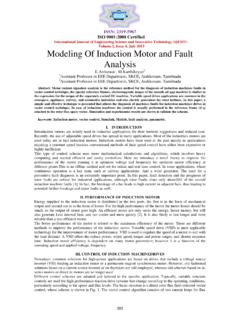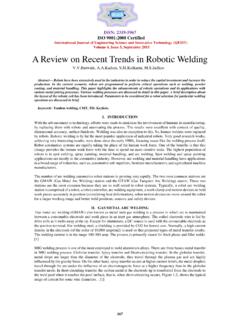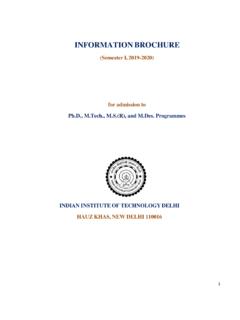Transcription of A Comparison Of Partial Least Square Structural Equation ...
1 ISSN: 2319-5967 ISO 9001:2008 Certified International Journal of Engineering Science and Innovative Technology (IJESIT) Volume 2, Issue 5, September 2013 198 A Comparison Of Partial Least Square Structural Equation Modeling (PLS-SEM) and Covariance Based Structural Equation Modeling (CB-SEM) for Confirmatory Factor Analysis Wan Mohamad Asyraf Bin Wan Afthanorhan Department of Mathematics, Faculty of Science and Technology, Universiti Malaysia Terengganu, 21030 Kuala Terengganu, Malaysia Abstract--In several years, Structural Equation modeling or popularly known as SEM is the first generation path modeling widely used by researchers and practitioners nowadays to analyze the interrelationship among variables in a model. Some of the researchers classify SEM as the covariance-based SEM (CB-SEM).
2 However, this method have been argued since its application should achieved the criterion before conducting the measurement and Structural model. Thus, Partial Least Square SEM (PLS-SEM) has been established to solve this problems. This paper aims to examine which one of the Structural Equation modeling is appropriate to use for confirmatory factor analysis by using SMARTPLS and AMOS. In this instance, the data of volunteerism program is chosen as a research subject to prove this issue. The author revealed that PLS-SEM path modeling using SMARTPLS is appropriate to carry on the confirmatory factor analysis which is more reliable and valid. Index Terms- AMOS, Confirmatory factor analysis, CB-SEM, PLS-SEM, Reliability and Validity, SMARTPLS. I. INTRODUCTION Structural Equation modeling (SEM) is first applied by Bollen (1989) and Joreskog (1973) in social sciences which is the academic advisor for Herman wolds (1973, 1975), the one who establish LISREL CB-SEM software package.
3 Then, PLS-SEM were develop much better by (Ringle, Wende, and Will 2005). According to Hair et. al (2010) explain CB-SEM is used to evaluate focuses on goodness of fit which is focusing on minimization of the discrepancy (differences) between the observed covariance matrix and the estimated covariance matrix. Its application is suggested appropriate to testing and confirmation where prior theory is strong or have a good reason to do so. However, the researchers or practitioners should achieve the assumption when conducting CB-SEM. The first one is the sample size of data should be large which is more than 200. Hair et. al. (2010) offer the minimum sample size depending on the model complexity and basic measurement model characteristics. According to Goodhue, Lewis and Thompson (2006), sample size should not be used as a main reason for employing PLS-SEM because it does not have adquate statistical power at small sample size.
4 They recommend PLS is a powerful method when a small sample size could be carry on compare to CB-SEM. The statistical software package for CB-SEM can be obtained in AMOS, LISREL, MPLUS and EQS while PLS-SEM in SMARTPLS and PLS Graph. Basically, each constructs should has more than three items (indicators) in order to avoid the identification problem. In the case where three indicators left in the model cannot be computed since the model just-identified and all values obtained from factor loadings are meaningless. Secondly, only the reliable and valid variance is useful for testing causal (direct) relationships. Means that, the Structural model cannot be conducted when prior of reliability and validity cannot be achieved. Thus, Partial Least Square SEM (PLS-SEM) has been established to solve this problems.
5 Its application is aimed to maximize the explained variance of the endogenous latent constructs (dependent variables) and minimize the unexplained variances. This method have several advantages which is include the normality of data distribution not assummed. Means that, the data with nonnormal can be conducted in Structural Equation modeling since its application is performed the non parametric method. Besides, indicators (items) with fewer than three for each constructs could be carry on since the identification issues has been overcomed. In addition, this models can be include a larger number of indicator variables even higher than 50 items. Instead, CB-SEM just accept several indicator variables to conducting the analysis since its limited. ISSN: 2319-5967 ISO 9001:2008 Certified International Journal of Engineering Science and Innovative Technology (IJESIT) Volume 2, Issue 5, September 2013 199 II.
6 LITERATURE REVIEW A. Evaluation of Measurement Models CB-SEM have performed three types of fitness indexes to achieve the fitness of measurement models before conducting the Structural models. Three categories of fitness is absolute, incremental and parsimonous fit besides ensure the reliability and validity could be achieved. According to Hair et. al. (1995, 2010) and Holmes-Smith (2006) recommend the use of at Least three fit indexes by including one index from each category of model fit. Absolute fit present three types of index which is chisquare, Root Mean Square Error Approximation (RMSEA) and Goodness Fit Index (GFI). Incremental fit proposed four types of index which is Adjusted Good of Fit (AGFI), Comparative Fit Index (CFI), Tucker Lewis Index (TLI), and Normed Fit Index (NFI).
7 Last but not Least , parsimonious fit indicates only one of index namely chisquare over degree of freedom. All of the fitness category should be achieved depending on their literature supported. Thus, the information concerning the fitness index category, their level acceptance, and comments are presented in following table as suggested by Zainudin Awang (2010). Name of Category Index Level of acceptance Literature Comments Absolute fit Chisquare P > Wheaton et. al. (1997) Sensitive to sample size > 200 RMSEA RMSEA < Browne and Cudeck (1993) Range to acceptable GFI GFI > Joreskog and Sorbom (1984) GFI = is a good fit Incremental fit AGFI AGFI > Tanaka and Huba (1985) AGFI = is a good fit CFI CFI > Bentler (1990) CFI = is a good fit TLI TLI > Bentler and Bonett (1980) TLI = is a good fit NFI NFI > Bollen (1989) NFI = is a good fit Parsimonious fit Chisq/df Chisq/df < Marsh and Hocevar (1985) Should be beyond Table 1 Given PLS-SEM have more potential compared to CB-SEM which is less strict assumption to be followed especially the fewer indicators can be conducted.
8 Thus, the identification issue could be avoided. For example Joreskog and Wold (1982) explain these result corroborate earlier writting and theorems, which indicated that PLS-SEM are asymptotically correct in the joint sense of consistency (large number of cases) and consistency at large (large number of indicators for each latent variable). In PLS-SEM have two types of measurement model which is reflective and formative measurement model. Thus, the researchers distinguish between these models to evaluate them (Henseler, Ringle, and Sinkovics 2009). In this case, this study would employ the reflective measurement model only since there are non item appropriate for formative measurement. Reflective measurement model should be assessed with the reliability and validity in order to achieve their consistency.
9 Construct reliability can be classify as composite reliability. According to Zainudin Awang, (2012) explain reliability is the extent of how reliable is the said measurement model in measuring intended latent constructs. Unlike Cronbach alpha that has been proposed by Nunally (1978) offer the value greater than indicate the mesurement model is reliable. Composite reliability values of to in exploratory research and values from to in more advanced stages of research are regarded as satisfactory (Nunally and Bernstein 1994) whereas values beyond indicate a lack of reliability. Given validity is the measure of the accuracy of an instrument used in a study (Linn, , 2000.; Stewart, , 2009). There are three types of validity which is convergent, discriminant, and construct validity as the presented below: Name of Category Index Level of acceptance Comments Convergent Validity AVE AVE > The validity is achieved when all items in a measurement model are statiscally significant.
10 Construct Validity GFI GFI > This validity is achieved when the fitness indexes achieve the following requirements CFI CFI > RMSEA RMSEA < Chisq/Df Chisq/Df < Discriminant Validity Square Root of AVE All the correlation This validity is achieved when the ISSN: 2319-5967 ISO 9001:2008 Certified International Journal of Engineering Science and Innovative Technology (IJESIT) Volume 2, Issue 5, September 2013 200 and correlation of latent constructs between these construct should below measurement model is free from redundant items. Table 2 Reflective measurement model s validity assessment focuses on convergent and discriminant validity. For convergent validity, researchers needs to examine the average variance extracted (AVE). According to Fornell and Larcker (1981), an AVE value of and higher indicates a sufficient degree of convergent validity, meaning that the latent variable (constructs) explains more than half of its indicators variances.















